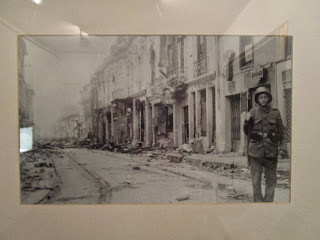 |
| A view of a room |
 |
| I told you it was a former prison |
 |
| Through the prison gates |
 |
| Ornate |
So just admire the beauty of the pieces:
That said, I do know the history of next piece:
 |
| Los Jesuitas en al Batalla de Lepanto. Artist anonymous. |
Continuing with what I cannot explain:
 |
| I call this one: Security Guard Contemplating a Stone Ball |
 |
| Noisy schoolchildren (are there any other kind?) on the floor above me |
Next we move onto a corridor that I did not need an English language translation: the pre-Columbian era of Colombian history:
There actually some English explanation of these exhibits. The most interesting thing I learned? This being Colombia and all, the word "pre-Columbian," which we use to mean "before Columbus," would make no sense. They call the time before 1492 the "prehispanic" era.
I recognized this guy:
San Agustin statuary! While it is nice to have a few of these statues in museums in Bogotá, it is even better to see them out in the open in the amazing San Agustin Archaeological Park, which oh by the way I visited back in 2012.
Continuing on, there was more "prehispanic" art on display in the big room:
This room seemed to be a survey of Colombian art, from both the prehispanic and the "hispanic" era of Colombian history:
What era is that piece from? Don't know. But I'd like to have one in my living room.
This definitely is not from the prehispanic era:
Clearly a modern take on the torture of St. Sebastian. It was there a lot of more modern art on the back wall:
Continuing on, there was more "prehispanic" art on display in the big room:
This room seemed to be a survey of Colombian art, from both the prehispanic and the "hispanic" era of Colombian history:
What era is that piece from? Don't know. But I'd like to have one in my living room.
This definitely is not from the prehispanic era:
 |
| San Sebastian en las trincerhas. Translation: St. Sebastian in the trenches. Ignacion Gomez Jaramillo, artist/ |
Continuing, yes, they had Boteros:
As you know, Botero is Colombia's most renowned artist. And all of the subjects in all of his works are fat. Muy gordo.
Yes, even the birds -- even the trees -- are fat fat fat.
But if you want to more Boteros, the Botero Museum in Candelaria is where to see them in Bogotá. But the best place to see Botero's work, including his most famous work depicting the killing of drug lord Pedro Escobar? Medellin.
I took pictures of whatever exhibits happened to catch my eye, No theme here:
 |
| Acción del llano de Santa Lucía. Jose Maria Espinosa Prieto, artist. |
I do realize light etchings on a copper plate does not show up well in a photograph. Just trust me on the way-cool-ness factor if you are a map nerd as am I.
But even without the etching being visible, it is still more cool than forcing students to look at modern art from the "industrial waste" side of the street. Here are some older schoolchildren being forced to look at what appeared to be a collection of bent tire rims.
There was genuine history on display:
This is a photo of the destruction wrought by the infamous "Bogotazo," a massive set of riots that occurred in 1948 following the assassination of a liberal presidential candidate. This one was in the same set of photos from the Bogotazo, but it looks more like a "before" to me:
Speaking of photographs, I found this art school scene interesting:
Children and nude sculpture. What possibly could be wrong with that?
Heading out of that corridor, with the children and their nude scupltures visible in the back, was this lass. This other lass was in a different corridor:
I liked these paintings.
This one requires no description:
 |
| Desnudo con Gallo. Pedro Nel Gomez, artist. |
But my favorite painting, the one that to me just had that special oomph to it, was this:
 |
| Palmas del Tolima. Ricardo Borrero Alvarez, artist. |
So it is time to exit the museum:
That corridor leads to the museum gift shop (very small), a restaurant, and the Juan Valdez coffee shop.
One last look at the prison exercise yard before exiting the museum grounds and heading back to the northern section of Bogotá:





















No comments:
Post a Comment